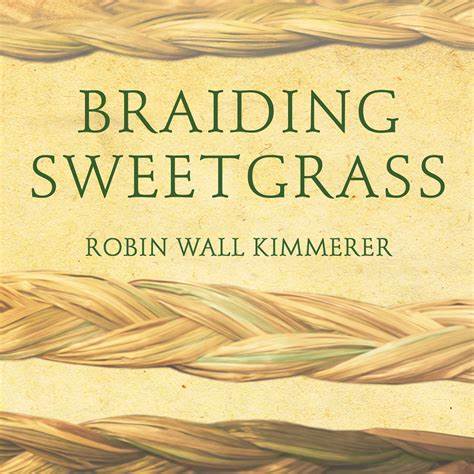Hold out your hands and let me lay upon them a sheaf of freshly picked sweetgrass, loose and flowing, like newly washed hair. Golden green and glossy above, the stems are banded with purple and white where they meet the ground. Hold the bundle up to your nose. Find the fragrance of honeyed vanilla over the scent of river water and black earth and you understand its scientific name: Heirochloe odorata, meaning the fragrant, holy grass. In our language it is called wiingaashk, the sweet-smelling hair of Mother Earth. Breathe it in and you start to remember things you didn’t know you’d forgotten.
A sheaf of sweetgrass, bound at the end and divided into thirds, is ready to braid. In braiding sweetgrass–so that it is smooth, glossy, and worthy of the gift–a certain amount of tension is needed. As any little girl with tight braids will tell you, you have to pull a bit. Of course you can do it yourself–by tying one end to a chair, or by holding it in your teeth and braiding backward away from yourself–but the sweetest way is to have someone else hold the end so you pull gently against each other, all the while leaning in, head to head, chatting and laughing, watching each other’s hands, one holding steady while the other shifts the slim bundles over one another, each in its turn. Linked by sweetgrass, there is a reciprocity between you, linked by sweetgrass, the holder as vital as the braider. The braid becomes finer and thinner as you near the end, until you’re braiding individual blades of grass, and then you tie it off.
Will you hold the end of the bundle while I braid? Hands joined by grass, can we bend our heads together and make a braid to honor the earth? And then I’ll hold it for you, while you braid, too.
I could hand you a braid of sweetgrass, as thick and shining as the plait that hung down my grandmother’s back. But it is not mine to give, nor yours to take. Wiingaashk belongs to herself. So I offer, in its place, a braid of stories meant to heal our relationship with the world. This braid is woven in three strands: indigenous ways of knowing, scientific knowledge, and the story of an Anishinabekwe scientist trying to bring them together in service of what matters most. It is an intertwining of science, spirit, and story–old stories and new ones that can be medicine for our broken relationship with earth, a pharmacopoeia of healing stories that allow us to imagine a different relationship, in which people and land are good medicine for each other.
Comprehension Questions
1. What does the author say the three stands in her sweetgrass braid represent?
A. Earth, wind and fire
B. Rock, scissors, paper
C. Science, spirit and story
A. Smells like cotton candy.
B. Smells like evergreen trees.
C. Honey, vanilla, river water and black earth
Your Thoughts
Vocabulary
4. List any vocabulary words below.

